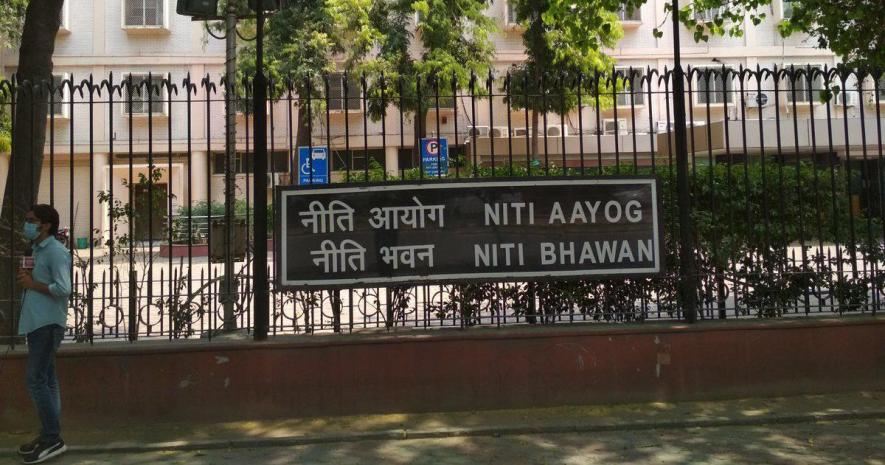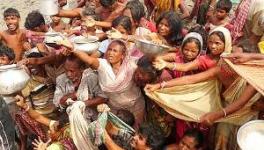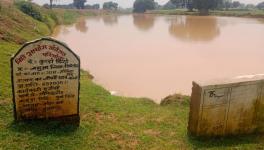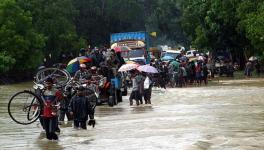NITI Aayog: Tunnel Vision and Apathy Hamper Progress?

Image Courtesy: Twitter
In the last week of January, the NITI Aayog released vision documents with proposals for the Little Andaman and Great Nicobar islands. Of all things, the body that represents post-planning India’s development strategies has concluded that developing the former into a megacity, complete with a free-trade zone that competes with Singapore and Hong Kong, is the way to go.
Surprisingly, the document on Little Andaman says that the “presence of indigenous tribes and concerns for their welfare” is “stopping” the Aayog from developing the two islands into “veritable jewels for the country”.
Aside from the tacit admission by the national think-tank that it does not consider the people and ecology of these islands “veritable jewels”, the proposals had environmentalists up in arms. Especially after the massive Tsunami hit the islands in 2004, turning their dense virgin forests into urban jungles is not how most people would imagine creating “jewels”.
The NITI Aayog’s field of vision on the environment, ecology, privatisation, and heritage had The Hindu newspaper highlight the existing disparities between Andaman and Nicobar and Singapore: The population density of the former is 47 people per sq km while it is 7,615 persons per sq km in Singapore. The per capita income is $1,789 in Andaman and Nicobar, compared to Singapore’s $55,182.
These figures highlight the huge demographic chasm between the Andaman and Nicobar Islands and Singapore, which are two hugely disparate cultures with different histories. The stark contrast between them only make NITI’s “vision” for Andaman-Nicobar highly unlikely to bear fruit.
A six-year history of walking backward
The vision documents are not the first time that the NITI Aayog has expressed outright disdain towards the ecology and vulnerable peoples. Its idea of “change” often means compromising on the essential aspects of life—livelihood, culture, and the natural world.
So for instance on 28 February the Aayog put out a discussion paper that proposes to slash food subsidies.
The paper says that economic growth over the past decade and resultant development, as well as the room in the National Food Security Act (NFSA) to reduce the allocation of subsidised food, would result in a certain “amount of savings” which the government would then spend on other important areas of concern such as health and education.
Thus it has recommended reducing the coverage ratio under the NFSA to 60-40 for rural-urban areas, from 70-50 at present, while updating the population to the present level. According to reports published in the Indian Express and Wire, the cuts would lead to annual savings of up to Rs. 47,229 crore.
And what of the fact that India is at 102nd position out of 122 countries on the Global Hunger Index? The Niti Aayog did not stop to wonder if health and education are subsets of the nutrition and food security. Why should Indians need to choose between health and education or food? These questions are not addressed by the Aayog.
Further, the BJP-led central government was widely criticised for ignoring the plight of the working class when it announced a lockdown at short notice last year. There were significant disruptions in the NFSA during the lockdown as well. Still, it has ushered in reforms that will accentuate their hardships.
The premier think-tank must have a vision for the poor beyond a Hobson’s choice of food or education or health.
These two instances should tell us where India is headed six years after the government refocused its development targets on “long-term” instead of five-year planning that informed the Planning Commission, which it has replaced.
Push for privatisation
The NITI Aayog and the NDA government are upfront supporters of privatisation, a fact that is not hard to recognise after it has delivered seven budgets. On 15 March, the NITI Aayog Vice-Chairman Rajiv Kumar said in an interview that he was “so glad” that he and the interviewer were both using the word “privatisation”, because “it seemed to have been banned for a few decades”. He also said that the Prime Minister has “made it very clear that it is back on the agenda...It also means giving greater space and opportunity to the private sector and starting the process of withdrawal of the government from sectors where it is not really required.” He confirmed the government plans to withdraw from strategic sectors as well.
The disinvestment target of Rs 1.75 trillion declared in Budget 2022 makes the massive push for privatisation more than apparent; though whether the government can meet these targets is another matter.
In 2018, a report released by the Department of Investments and Public Asset Management (DIPAM) stated that disinvestment worth Rs. 3.63 lakh crore has taken place in India since 1991. Out of this, disinvestment of public assets worth Rs. 2.1 lakh crore took place in just four years of the NDA regime (2014-18).
These four years account for 58% of all the divestments since liberalisation. Where, then, does the question of disinvestment being a “banned word” arise?
Kumar claims the Niti Aayog is trying to determine whether the private sector could “move into the small nuclear reactor business”. The idea of inviting private hands into a sensitive industrial sector could heighten risks including nuclear pollution, which is extremely detrimental to the environment, especially marine habitats.
Already, the Atomic Minerals Directorate (AMD), responsible for the exploration of uranium deposits, is facing stiff resistance in prospecting for mines. The topmost concern raised by people is the destruction of natural life and health risks during the mining operations.
No robust data-collection system
The very basis for the Niti Aayog’s decisions ought to be research and data based on which it must formulate policies. Yet, little has been done by the think-tank to correct the lag in the release of administrative data. And, in the six years since its genesis, scientific surveys and data collection have hardly been NITI’s concern. If the primary requirement for data is unfulfilled, then what has been its basis for policy-making so far?
One could even argue that the lack of robust and reliable data and statistics gives rise to opportunities for propaganda and making tall claims—easier, then, to mislead the public by concealing the reality. This happened in 2019 when the NITI Aayog withheld a crucial report on employment and unemployment statistics.
The Niti Aayog sought to characterise this report as a “draft” while the chairperson of the National Statistical Commission, which conducts the surveys, claimed it was a final report.
The report had recorded a surge in the unemployment rate to over six percent—a 45-year high. PC Mohanan, the acting chairperson of the National Sample Survey Office, which oversees the Statistical Commission, quit along with his JV Meenakshi a Member of the NSC over this fiasco.
Earlier, there were allegations that the GDP data is unreliable too.
Therefore, the NITI Aayog seems to have succumbed to “AC-room planning” instead of survey-based planning. That is how visions like those for Andaman and Nicobar come to be released without considering the data—for such facts might plant pertinent questions in the minds of people.
Ecological concerns versus economic concerns
On 5 February 2021, the NITI Aayog announced that it is going to study the unintended economic impact of Supreme Court and National Green Tribunal verdicts in favour of preserving nature or the environment. Two days later, on 7 February, there was a natural disaster in the eco-sensitive Chamoli district of Uttarakhand, where several power projects are under construction.
The disaster damaged the NTPC-run Vishnugad-Tapovan project and the Rishiganga hydel power project. Major impact study groups have blamed these power projects for contributing to the tragedy. The Niti Aayog is yet to commission any study into the disaster which has claimed 72 lives, and in which 133 went missing.
Instead, the Aayog wants the Consumer Unity and Trust Society (CUTS), a Jaipur-based NGO, to study the MOPA international airport at Goa, the Sterlite Copper plant at Thoothukudi in Tamil Nadu, the issue of sand mining in Uttar Pradesh, the construction ban in New Delhi and iron ore mining in Goa.
This is because according to a NITI Aayog note these projects are among the “most significant cases in the recent past that have caused substantial damage to the economy.”
It wants the judiciary to “take into account environment, equity and economic considerations while deciding cases, and needs to institutionalise a mechanism for it…” It rues the lack of analysis of economic costs associated with judicial decisions. Costs which, according to it, are “exacerbated when judicial activism by courts and tribunals is also in play”.
The irony is that forest officers, scholars, scientists, and policy analysts are critical of the “vision” document of the NITI Aayog for the Andaman and Nicobar islands because no Environmental Impact Assessment has been done for these projects. Meanwhile, NITI Aayog wants the top court and NGT to do an “economic assessment” of their rulings in which they have backed environment protection.
The human rights group Global Witness, had said in a report that India had the third-highest number of deaths of people defending their land in 2018. Out of the 23 deaths, 13 were in Thoothukudi alone, during the anti-Sterlite protests—and the Niti Aayog wants the economic impact alone analysed.
This reality is a clear indication that at the micro-level, the “transformative” decisions of the Niti Aayog ignore all suffering, loss, and death of the vulnerable. Land does not only shelter people but gives them some security in a world full of risks and uncertainty. It is land that assures survival in tough times.
Be it the expansion of a copper smelter in Thoothukudi or the “vision” for Andaman-Nicobar as Singapore, it is always the people who risk losing their livelihood, habitat, culture, even lives, while others stand to benefit or earn big. This cost-benefit analysis is also the job of the government and the Aayog.
Corporate autocracy
An Oxfam report recently revealed that India’s one percent richest hold over 40% of the national wealth. The planning and developmental body along with the government only seem to be keen on maximising this disparity.
As the new “Planning Commission”, the Niti Aayog must manage and coordinate Centre-state relations, which the Modi government calls “cooperative federalism”. It should have focused on strengthening development as an organic and independent process. It should have developed a strong feedback system to assess changes on-ground and check implementation.
NITI has been given a new and powerful role but it seems it wants to stick to the role of being a government agency, and nothing more.
The author is an independent journalist based in Jharkhand. He specialises in political analysis, reporting on tribal issues, education, and the environment. The views are personal.
Get the latest reports & analysis with people's perspective on Protests, movements & deep analytical videos, discussions of the current affairs in your Telegram app. Subscribe to NewsClick's Telegram channel & get Real-Time updates on stories, as they get published on our website.
























